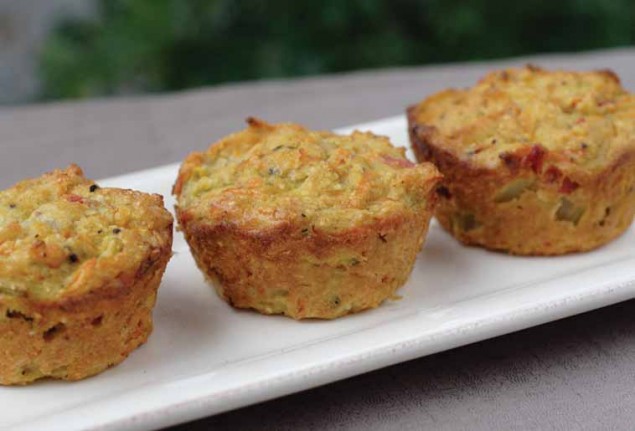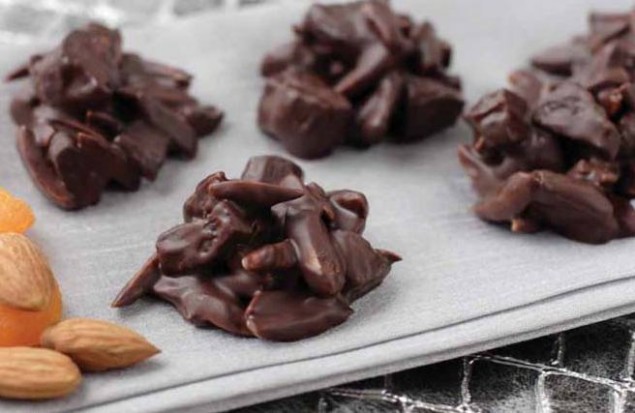Healthy Passover Pleasures
Most traditional Pesach recipes are high in calories, carbohydrates and fat, but are low in fiber. Traditions are hard to break and favorite foods are difficult to “pass up,” especially during a holiday. To help you eat well even during Pesach, here are some healthy and delicious recipes that are sure to please the guests at your table. I’ve also included some helpful tips to make your Pesach preparations easier. Enjoy without guilt!
Plan Ahead: Each year, go through your favorite recipes. Photocopy those that are “keepers,” and note any necessary adjustments. Similarly, keep your menus and grocery lists from previous years as a helpful guide and store them in clear plastic page protectors. That way, you’ll be organized for Pesach and will know what to buy for the current year. Don’t be afraid to try new recipes, but it’s a good idea to try them ahead of the Seders to ensure that your family will like them.
Shop Smart: Fill your grocery cart with fresh fruits and vegetables, lean meats, poultry, fish and low-fat dairy products. Beware of processed foods, as they are often loaded with fat, carbs and sodium. Don’t shop when you are hungry—you’ll buy too much junk food.
Boost the Fiber: Choose whole wheat matzah whenever possible. Whole wheat matzah contains three to four grams of fiber per sheet, whereas plain matzah contains only one gram. To get additional fiber, eat lots of fresh fruits and vegetables.
Portion Distortion: You don’t need to eat everything on the table! Eat slowly—it takes twenty minutes for your brain to know when the stomach is full.
Know What to Eat: Choose lower-fat dishes when possible—chicken, turkey and fish are leaner protein choices than meat. Also, soups, salads and vegetable dishes are healthier options than traditional starchy Pesach dishes.
Leftover Wine: Refrigerate leftover wine or freeze it in ice cube trays, storing the cubes in resealable freezer bags. These cubes can later be added to various recipes; wine adds flavor to meat, poultry and sauces.
Dessert Dilemma: Focus on fruit for dessert. Most fruits are low in calories, and they also have a low glycemic index (GI). Berries are best. When choosing a high GI dessert, top it with fruit to bring the glycemic index down to a more moderate level. It’s okay to indulge, but keep your portions small! A little bit of chocolate also goes a long way.
Miniature “Notsa” Balls (Chicken Kneidlach)
Makes 2 dozen miniature balls
These low-carb chicken kneidlach are a luscious alternative to regular matzah balls. You can also substitute ground almonds for matzah meal, which makes the balls gluten free. Make your favorite recipe for chicken soup or vegetarian broth and serve it with these delicious, guilt-free kneidlach.
1 medium onion, cut into chunks
1 celery stalk, cut into chunks
2 tablespoons fresh dill
1 pound lean ground chicken or turkey
1 large egg
1 tablespoon vegetable or olive oil
3 tablespoons matzah meal (or ground almonds)
1/2 teaspoon salt
Freshly ground black pepper
2 tablespoons club soda or cold water
10 cups salted water
Using the steel blade of a food processor, process the onion, celery and dill until minced, about 10 seconds. Add the ground chicken, egg, oil, matzah meal (or almonds), salt, pepper and club soda; process just until mixed. Transfer to a bowl, cover and chill for 20 to 30 minutes.
In a large pot, bring the salted water to a boil. Wet your hands and shape the mixture into walnut-sized balls. Drop balls into the boiling water, cover tightly and simmer for 20 to 25 minutes or until cooked through. Don’t peek! Using a slotted spoon, carefully remove the balls from the water and transfer to bowls of hot chicken soup or vegetable broth.
Note: These “notsa” balls keep for up to 2 days in the refrigerator, and they reheat well. They also freeze well for up to 3 months.
Nutrition Info: 39 calories each, 1.4 grams carbohydrate, 0.1 gram fiber, 3 grams protein, 2.3 grams fat (0.6 gram saturated), 21 milligrams cholesterol, 65 milligrams sodium, 17 milligrams potassium, 3 milligrams calcium
With ground almonds, each ball contains 40 calories, 0.7 gram carbohydrate, and 2.6 grams fat.
Chef’s Secrets:
Hidden Treasure: Stuff the notsa balls with any of the following: shredded carrots, finely minced parsley, cooked chopped spinach, sautéed chopped mushrooms or onions. To stuff, poke a hole with your finger in the center of each ball. Close the opening and re-roll the balls so that the filling is hidden.
Frozen Assets: “Notsa” balls can be cooked in advance, then frozen in chicken soup. Alternatively, cook them in a single layer on a cookie sheet or in muffin pans until firm, then transfer to plastic freezer bags and freeze until needed. There’s no need to thaw first—just reheat them directly in the simmering soup! They will take about 10 minutes to defrost.
Grind It Right: Ground chicken usually contains dark meat, which increases the fat content. Ask your butcher to grind skinless, trimmed chicken breasts. Or, you can grind the chicken breasts yourself in a food processor. Cut 1 pound chilled boneless, skinless chicken breasts into 1-inch chunks and process 15 to 20 seconds until minced.
 Pesach Vegetable Muffins
Pesach Vegetable Muffins
Photos: Estee Gestetner
“Notsa” Balls from a Mix
Makes 3 dozen miniature balls
This tasty, low-carb recipe uses a packet of matzah ball mix. Serve the “notsa” balls in chicken soup or as a side dish. They also taste terrific when reheated in the defatted pan juices from brisket or roast chicken.
1 pound lean ground chicken
2 large eggs (or 1 large egg plus 2 egg whites)
1 tablespoon oil
3 tablespoons club soda or cold water
1 tablespoon minced fresh dill
1 packet matzah ball mix (or gluten-free matzah ball mix)
10 cups salted water
In a large bowl, combine the ground chicken with the eggs, oil, club soda, dill and matzah ball mix; combine well. Cover and chill for 20 to 30 minutes.
In a large pot, bring the salted water to a boil. Wet your hands and shape the mixture into walnut-sized balls. Drop into the boiling water, cover tightly and simmer for 40 to 45 minutes or until cooked through. Don’t peek! Using a slotted spoon, carefully remove the balls from the water and transfer to bowls of hot chicken soup or vegetable broth.
Note: These “notsa” balls keep for up to 2 days in the refrigerator, and freeze well for up to 3 months.
Nutrition Info: 30 calories each, 1.4 grams carbohydrate, 0.1 gram fiber, 2 grams protein, 1.7 grams fat (0.4 gram saturated), 20 milligrams cholesterol, 97 milligrams sodium, 4 milligrams potassium, 6 milligrams calcium
Honey ‘N Herb Turkey Breast
10 servings
Everyone at your table will gobble this up! Mango juice adds a marvelous flavor to the turkey, but orange juice will also add its own special twist.
3 onions, thinly sliced
1 red pepper, seeded and sliced
1 boneless rolled turkey breast (about 4 pounds)
Salt
Freshly ground black pepper
Paprika
1 cup mango or orange juice
Marinade:
2 tablespoons extra virgin olive oil
2 tablespoons lemon juice (preferably fresh)
2 cloves garlic (about 2 teaspoons minced)
2-3 tablespoons honey
1/2 teaspoon dried basil
1/2 teaspoon dried thyme
Spray a roasting pan with cooking spray. Place the onions and red pepper in the bottom of the pan. Rinse the turkey breast and pat dry. Place the turkey on top of the vegetables; season with salt, pepper and paprika.
In a small bowl, combine the marinade ingredients; mix well.
Drizzle the turkey and vegetables with the marinade, coating the turkey on all sides. Drizzle the mango juice over and around the turkey. Cover and refrigerate for 1 hour or up to 2 days, basting occasionally. Remove from the refrigerator about 30 minutes before cooking.
Preheat the oven to 350°. Roast the turkey, covered, for about 2 hours (about 25 to 30 minutes per pound). Uncover the turkey for the last 30 minutes of cooking; baste occasionally. When done, the juices will run clear when pierced with a fork, and a meat thermometer, when inserted into the thickest part of the bird, should register an internal temperature of 165 to 170°.
When the turkey is cooked, remove the pan from the oven, cover and let stand for 20 minutes before thinly slicing. Serve with the pan juices.
Note: The turkey will keep for 2 to 3 days in the refrigerator, and it reheats well. It also freezes well for up to 4 months.
Nutrition Info: 263 calories per serving, 11.3 grams carbohydrate, 0.7 gram fiber, 44 grams protein, 3.9 grams fat (0.7 gram saturated), 119 milligrams cholesterol, 83 milligrams sodium, 498 milligrams potassium, 3 milligrams iron, 33 milligrams calcium
Chef’s Secrets:
Be Prepared: Prepare and cook the turkey breast as directed. Thinly slice and place in a casserole dish; top with pan juices. Refrigerate for 1 to 2 days. Reheat, covered for 20 minutes at 350°.
No Bones About It: If a rolled turkey breast isn’t available, use an unrolled turkey breast, allowing 20 to 25 minutes cooking per pound. If you can’t find one large turkey breast, use 2 smaller ones. Use an instant-read thermometer to prevent overcooking.
Pesach Vegetable Muffins
Makes 10 muffins
Vegetarian heaven! These colorful veggie muffins make an excellent side dish or are perfect as a healthy snack. I like to throw in some garlic, red pepper and fresh dill to add color and boost the flavor. A food processor helps to speed up the preparation and is well worth the investment.
2 tablespoons olive oil
1 medium onion, chopped
1 clove garlic (about 1 teaspoon minced)
1/2 red or green pepper, seeded and chopped
1 celery stalk, chopped
1 1/2 cups grated carrots
1 cup grated zucchini, well-drained (about 1 small zucchini)
3 large eggs, lightly beaten
3/4 teaspoon salt
1/4 teaspoon freshly ground black pepper
3/4 cup matzah meal
1 tablespoon chopped fresh dill (or 1 teaspoon dried)
Preheat the oven to 375°. Spray 10 compartments of a muffin pan with cooking spray and fill 2 compartments with water.
Heat the oil in a large nonstick skillet on medium high heat. Sauté the onion and garlic in hot oil for 5 minutes or until golden. Add the pepper, celery, carrots and zucchini. Reduce heat to medium and sauté for 5 to 7 minutes longer, until tender, stirring occasionally. Let cool.
Stir in the eggs, salt, pepper and matzah meal; mix well. Scoop the batter into the compartments of the muffin pan. Bake for 35 to 40 minutes or until golden brown. Cool slightly, then carefully remove from pan.
Note: This recipe easily doubles and triples. The muffins keep for 3 to 4 days in the refrigerator and reheat well. They also freeze well for up to 2 months.
Nutrition Info: 100 calories per muffin, 11.6 grams carbohydrate, 0.8 gram fiber, 3 grams protein, 4.4 grams fat (0.8 gram saturated), 63 milligrams cholesterol, 269 milligrams sodium, 128 milligrams potassium, 1 milligram iron, 19 milligrams calcium
Vegetable Kishka
Makes 48 slices
Prepare the vegetable mixture above as directed. Spoon half of the mixture onto a sheet of foil that has been well-sprayed with cooking spray. Wet your hands for easier handling and form the mixture into a long roll, about 2 inches in diameter. Wrap well in foil. Repeat with the remaining mixture. Place both rolls on a baking sheet and bake at 375° for about 45 minutes. Unwrap and cut into 1/2-inch slices.
Variations:
Try using parsnips, broccoli or an herb such as basil or parsley instead of carrots, zucchini or dill.
 Chocolate Almond Apricot Clusters
Chocolate Almond Apricot Clusters
Chocolate Almond Apricot Clusters
Makes 48 clusters
These chocolates are so good, you’ll pray they last until the end of Pesach! Chocolate lifts your spirits when you’re feeling tired and overwhelmed with Pesach preparations, and these no-bake treats are the perfect “pick-me-up.” They are also a wonderful and easy gift to bring to a Seder. Everyone will “cluster” around you when you bring these to the table!
10 ounces good-quality dark chocolate
(bittersweet or semi-sweet)
1 tablespoon vegetable oil
2 cups toasted almonds, sliced or slivered
1 1/2 cups dried apricots, cut up
Break the chocolate into chunks and place in a large, dry microwaveable bowl. Microwave on medium, uncovered, for 2 minutes, then stir. Continue microwaving on medium for 1 to 2 minutes longer until the chocolate is just melted; stir well. Cool slightly before stirring in oil, almonds and apricots.
Drop the mixture by teaspoonfuls onto baking sheets lined with parchment paper. Refrigerate for 30 to 45 minutes or until firm. Transfer clusters to an airtight container, separating the layers with parchment or waxed paper.
Note: The best way to cut the apricots is to use scissors. The clusters keep for 2 to 3 weeks in the refrigerator—if you hide them well! They also freeze well for up to 4 months.
Nutrition Info: 66 calories per piece, 6.7 grams carbohydrate, 1.2 grams fiber, 1 gram protein, 4.9 grams fat (1.5 grams saturated), 1 milligram sodium, 84 milligrams potassium, 12 milligrams calcium
Norene Gilletz is a cookbook author and culinary consultant in Toronto, Canada. She is the author of seven cookbooks, including her latest, Norene’s Healthy Kitchen (Toronto, 2008). For more information, visit her web site at www.gourmania.com.

